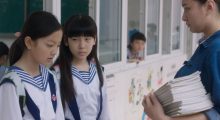Festivals & Events
Festivals & Events
-
Sundance 2018 Critic’s Notebook, Day 4: Eighth Grade, Shirkers, Piercing

I suppose I should lead with Bo Burnham’s Eighth Grade, one of the fest’s breakouts or something along those lines — it arrived as an A24 production with Scott Rudin as one of the producers, so clearly people were going to be curious. The title is basically the movie: in her last week of middle school hell, awkward Kayla (Elsie Fisher) — voted by her otherwise indifferent classmates as most quiet — fumbles through a cool kids’ pool party she shouldn’t be at. Kayla shadows a high school senior and is invited to hang out with her crew. That temporary boost […]
-
A Monster Unleashed at Sundance

I recall the first time I heard the word “Sundance” uttered. A friend had returned from the mythical mountains of Utah and, like a sage returning home from a quest, dropped a book in front of me. I scoured that festival program guide — studying every photo and accompanying film description — hoping that some filmmaking knowledge, and maybe even a little magic, would rub off on me. It was the early ’90s, and indie film was filled with starry-eyed promise. After all, those were the days of pre-sales, physical media and the elusive multi-picture deal. When I finally made […]
-
Sundance 2018 Critic’s Notebook, Day 3: Crime + Punishment, Monsters and Men, Bisbee ’17

I’ve written before about my fondness for local news: “a fun, seemingly randomized mash-up of crimes caught on security cameras, traffic and weather updates, forced banter, cooking segments, deep concerns about marijuana use and ‘reporting’ that’s thinly veiled support for the NYPD.” One segment in the latter mode still regularly replays in my mind: following the 2014 shooting of two NYPD officers, one channel — playing to that unflappable demographic which believes the police are always in the right — aired a particularly shameless segment in which a reporter found a seven-year-old black child to tearfully state how much he […]
-
Ask Not What Festivals Can Do For You….

As filmmakers, we sometimes get so concerned with what film festivals can do for us and for our films that we forget about what our films can do for the festivals, and more importantly, for their local audiences. This year more than ever, I’ve seen festivals in communities around the world overcome violence, natural disasters and other communal sources of anxiety to put on amazing celebrations of cinema. They’re helping to spark conversations, rebuild damaged economies and in general just get people celebrating again with their neighbors, friends and visiting filmmakers. I’ve had a first-hand look at some of these […]
-
Sundance 2018 Critic’s Notebook, Day 2: Clara’s Ghost, Hale County This Morning, This Evening

For the second consecutive year, Sundance showed an Academy-ratio film with Ghost in the title, but Bridey Elliott’s feature directorial debut Clara’s Ghost is decidedly not A Ghost Story. Bridey stars along with father Chris, sister Abby and mom Paula (the only non-actor in the bunch, though she easily holds her own). The plot’s loose: sisters Riley (Bridey) and Julie (Abby) — former child stars as the Olsen-esque Reynolds sisters — come for a one-night visit home. Father Ted (Chris) has just lost his casting in a show being put together by Julie’s fiance and is feeling rancorous. Some magazine photographers come over to take […]
-
Sundance 2018 Critic’s Notebook, Day 1: Our New President, Three Identical Strangers

Two things shape my Sundance coverage this year — one purely personal, the other macro. The personal was recently reading Christian Metz’s Film Language, the kind of text normally consumed in undergrad cinema studies (not my major) but belatedly a worthwhile book all the same; I wanted some new tools to think about movies, and this fit the bill. The opening essays are recognizably Barthes-ian contemplations of i.e. what makes the moving image more plausible than a still image and the middle gets mired in a lot of precise definitions of paradigmatic vs. syntagmatic, but the finale is a surprisingly fiery, […]
-
25 Films We’re Excited about at the 2018 Sundance Film Festival

Sundance starts tomorrow, and just before the curtain raises we’re squeaking in with a list of films our correspondents — Vadim Rizov, Meredith Alloway and myself — are excited to see. I’m about to start packing, and colleagues from other magazines and companies are Facebooking their SARS-mask covered faces on their way to the influenza petri-dish of Park City. I could spin this intro out longer — quote Sundance festival director John Cooper on how this year’s festival is full of “alternative voices” — or perhaps left-turn into some metaphor or another, but I’ll just do what we do here […]
-
Pingyao Year Zero: A Report from China’s First Authority-Approved, Privately Operated Film Festival

Much has been written on the proliferation of film festivals over the last two decades or so. Tentacular events in whose midst commercial imperatives and nobler intentions (or alleged such) dialectically coexist, festivals can be many things, but rarely do they feel as vital and unprecedented as the first edition of the Pingyao Crouching Tiger Hidden Dragon International Film Festival (PYIFF). Unprecedented indeed it was, for the festival founded by the Chinese director Jia Zhangke is the first ever in China to be approved by the authorities but operated by a private company. This organizational set-up allowed its founder and […]
-
A Year in 17 Festivals: A Look Back at the Movies, and the Movie Theaters

Rotterdam Film Festival The year started with my first visit to the Rotterdam Film Festival, which is once again being seen as a festival for experimental and challenging films under the auspices of Artistic Director Bero Beyer and which offers an eclectic mix of cinemas. The Willem Burger Complex — where I saw a number of films, including one-time Spike Lee cinematographer Ernest Dickerson’s Double Play, a playful but ultimately unsatisfactory adaptation of Frank Martinus Arion’s Curaçao-set novel — is a beautiful building designed for conferences, but the seats do make you feel like you’re in a lecture hall, befitting […]
-
Our Stories are True: Porto/Post/Doc 2017

“The sky above the port was the color of television, tuned to a dead channel.” opens William Gibson’s Neuromancer, set in Chiba, Japan (while generally accepted as a reference to the novelist’s home in Vancouver). A similar pall intermittently lingered over the northern Portuguese city of Porto during the city’s Porto/Post/Doc festival. The pallid grey and smoke were reminders of the devastating fires that have engulfed northern regions of the country since the summer, claiming many lives. The cinematic image of smokey cobblestone streets — with a knowledge of the real, if unseen forces behind them — provided a somber and […]










